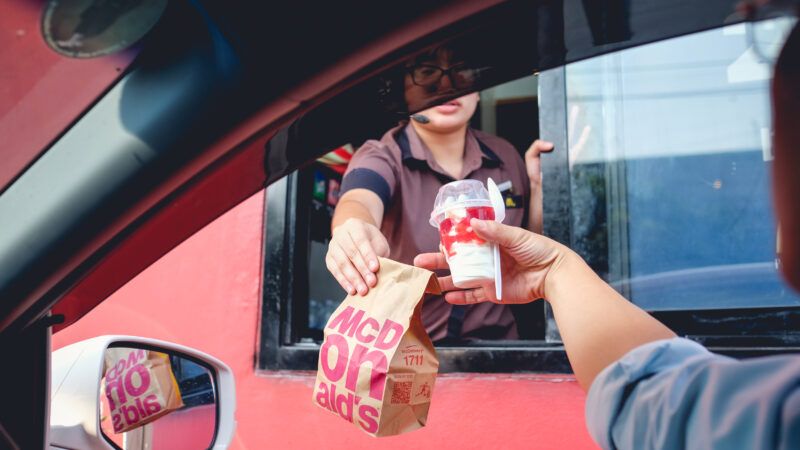The War on Fast-Food Joints
Cities around the country are contemplating bans on drive-thrus and other new regulations.

From the perennial fights over Chick-fil-A to claims that fast food disproportionately hurts low-income and minority communities via poor nutrition, it's easy to see how fast food entered political debate. But far from being limited to culture war clashes, the business model of the industry itself is increasingly under attack.
The battlefront starts with so-called "joint employer" or "joint liability" standards, which the National Labor Relations Board (NLRB) is expected to officially impose soon. This would essentially require franchisee employees to be counted as employees of the franchisor parent corporation by holding the franchisor liable for the actions of its individual franchisees. It also would make it easier for unions to organize at the parent company level, rather than via individual franchise outlets. Progressives have been pushing for years to impose joint employer standards onto the franchise model, and the Biden administration is echoing the Obama administration in following through (after a brief hiatus during Donald Trump's presidency).
The NLRB's rules on joint employers tend to flip-flop every four to eight years depending on who controls the White House, so it's little surprise that the Biden administration is poised to reopen this debate. The Federal Trade Commission (FTC) is also currently contemplating getting involved in the debate. But beyond administrative dictates that can be tweaked by phone and pen, Democratic lawmakers have also tucked joint employer standards into the notorious Protecting the Right to Organize (PRO) Act floating around Capitol Hill, which includes a laundry list of legislative priorities for organized labor.
Left-leaning policy makers are not stopping at the federal level, either, as states like California are also considering joint liability bills. Last year, when California passed its controversial FAST Recovery Act, which not only raised minimum wages for restaurant workers to $22 an hour but also created a 10-member Fast Food Council to oversee and regulate the entire industry, the legislation also included new joint liability rules.
The joint liability language was removed from the bill before it passed, but once the franchise and restaurant industry fought back by getting a referendum for the FAST Act to qualify for the 2024 ballot, liberal state lawmakers suddenly reintroduced a stand-alone joint liability bill. The joint liability idea is already spreading beyond the Golden State—ironically known as the birthplace of fast food—to states such as New York.
Attacking the franchise model makes little sense for those interested in helping more Americans climb the income ladder. Being the proprietor of a franchise has long been seen as one of the preeminent—and most readily accessible—ways to achieve the American dream. Franchise ownership often requires lower startup capital compared to other types of businesses and provides training in the requisite expertise and knowledge needed to operate the business.
As a result, the franchise model is recognized as providing more opportunities for those in underrepresented communities. This is reflected in the ownership numbers, as 30 percent of franchises are minority-owner compared to only 18 percent of other types of businesses. Some have even called the franchise system "the safety net of the economy," since a recently laid-off worker in an unrelated sector can turn around and buy a franchise and receive the guidance needed to succeed.
According to the International Franchise Association, the Obama-era version of the joint employer standard cost franchises over $33 billion annually and resulted in 376,000 lost job opportunities. Perhaps most alarmingly, it led to an over 90 percent increase in litigation against franchises.
The corporate legal structure of fast food is not the only aspect of the industry facing threats. The iconic drive-thru window itself is under assault, as cities and municipalities across the country are contemplating—or have already passed—drive-thru bans. Pushed under the guise of "smart urban planning" and walkable communities, proponents argue that drive-thrus create traffic congestion and discourage walking.
But once again, these bans mostly serve to hurt businesses and workers. On average, drive-thru sales comprise between 50 percent to 70 percent of sales for fast-food outlets—and unsurprisingly were an even more vital lifeline during the pandemic. Further, drive-thru windows can be a way to protect worker safety, particularly in late-night settings where keeping employees behind the barrier of a drive-thru window may create less risk than keeping the dining room open.
Many restaurants also continue to face significant labor shortages—with 62 percent of operators reporting they lack the requisite number of employees to meet demand—and drive-thru-only restaurants require less labor than on-premise dining. In addition, surveys indicate consumers prefer carry-out rather than dine-in at quick service restaurants, so these eateries are simply responding to consumer preference.
It's no secret that the modern left is waging a clandestine "war on restaurants," and the fast-food franchise industry appears to be ground zero for the attack. The proprietors of these small businesses and their customers stand to lose if policy makers undermine the franchisee-franchisor model and ban drive-thrus.



Show Comments (53)